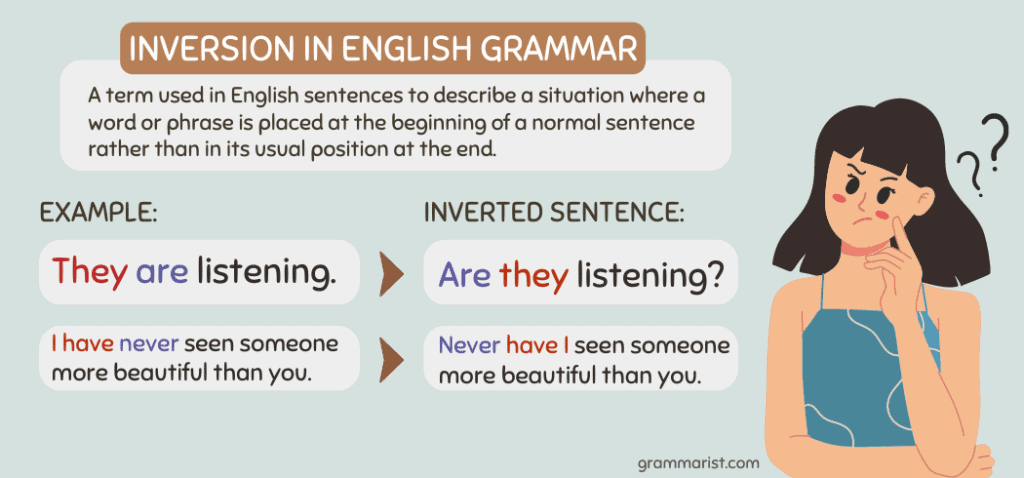Such a mystery is English grammar inversion that we wonder how we can decipher it. When looking to expand your English vocabulary and upgrade your writing to more than just subject-plus-verb sentences, inversions can be of great help. See what inversion grammar is, how to use it in a sentence, and explore the different situations where it might be useful as I explain everything.
Inversion Explained
Inversion is a style where we change the natural order of the words in a sentence. I know it sounds strange, but it can work when done well. This goes beyond the inversion of a subject and verb and is used with more complexity to creating interesting sentence structures.
What Is an Inversion in English Grammar?

Inversion is a term used in English sentences to describe a situation where a word or phrase is placed at the beginning of a normal sentence rather than in its usual position at the end. It means you’re changing the natural order of the words in a sentence.
This can be used for stylistic purposes, to create a more complex or emphatic sentence structure, or simply for variety. In many cases, inverting words and phrases also involves changing their order from normal.
I’ve used it in my own writing from time to time. But if you’re writing fiction, I’d advise you to use this writing device sparingly.
A common type of inversion involves using adverbs or adjectives before main verbs. An inversion is a useful tool that can help to add variety and complexity to sentence structure, whether you are writing casually or formally.
Inversion of subject sentence examples:
- Never have I been more insulted in my life!
- Gone are the days when this used to be a peaceful town.
- Such greatness lies in the human heart; it knows no boundaries.
- Had you paid attention to me, we wouldn’t be in this mess!
What Are Inversions in Writing?
An inversion can contribute to various effects, from adding emphasis to creating a sense of suspense or irony. For instance, instead of saying, “I will go there tomorrow,” one might use an inversion by saying, “Tomorrow I will go there.”
In this case, the unexpected word order adds a subtle sense of urgency to the statement by pulling the focus away from the expected subject and verb.
This emphasis could be further strengthened by using an inversion and emphatic stress, such as “Right now, I have to go there!” or “Not today – tomorrow!”
Other techniques for using inversions include intentionally misdirecting the reader by inverting explicit clues to obscure certain information or drawing attention to certain key elements through unusual syntax.
Ultimately, an effective writer needs to carefully consider both the effect that they want to achieve and how best to accomplish it with the craft tools at their disposal – which may very well include the use of an inversion.
Why Is Inversion Used in English?
Inversion plays an important role in English grammar, providing a variety of functions both within and across sentences. For starters, inversions are often used to create a rhetorical impact or express surprise.
This can be seen, for example, in expressions like “Here comes the Sun!” where the normal word order is inverted for greater emphasis. In addition, inversions are often used to focus on a specific part of the sentence.
For instance, if we wished to highlight a particular object as being unique or noteworthy in some way, we might insert an “inverted” object into our phrasing: “A fugitive was all that lay between me and freedom.”
Inversion is used for formal, dramatic, or emphatic purposes.
What Are the Types of Inversion in Grammar?

The most common type of grammar inversion is when we form questions.
For example:
- They are listening. -> Are they listening?
Another type of grammar inversion is when we have negative adverbs. In formal writing and speech, adverbs with negative meanings go at the start of the sentence for added emphasis.
Some negative adverb examples include scarcely, seldom, never, hardly, rarely, etc.
Examples of inverted sentences with negative adverbs:
- Rarely does one see a gesture of good faith these days.
- Never have I seen someone more beautiful than you.
“Here” and “there” are words that can also be found in inverted sentences. They have to be used as adverbs of place to create an inversion.
Examples:
- Here is the book you wanted to borrow.
- I glanced across the room, and there was Candace in her beautiful red dress.
Another type of inversion in English is when we have “so” and “such.” To form inversions, remember the following two formulas:
- So + adjective + that + to be
- Such + to be + noun
Let’s look at this type of inversion in a sentence:
- So mesmerizing was the night that we met.
- Such are the troubles of the human mind.
You can also form an inversion by starting a sentence with the word “little.”
For example:
- Little did I know who was at the other end of the phone line.
Here is a more comprehensive list of negative adverbs and phrases used to make inversion:
- Only later
- Not only
- In no way
- Seldom
- Scarcely
- Rarely
- Never
- Hardly
- Only then
- Only in this way
- On no account
- No sooner
- So
- Such
- Only by
- Under no circumstance
Inversion With the Present Simple and Past Simple
When we speak or write in the present simple and past simple tenses, we don’t use any form of the auxiliary verb “to do.”
This means that when looking to create inversions, auxiliary verbs are used the same as when forming questions.
If you’re confused, here is what these inversions would look like:
- She rarely shows up on time.
- Rarely does she show up on time.
Inversion in Questions
You can take any normal sentence and invert it into a question.
- John will go to the university. (Normal sentence)
- Will John go to the university? (Question)
- Celia has done the homework. (Normal sentence)
- Has Celia done the homework? (Question)
Wrap Up
Inversion is a style where we change the natural order of the words in a sentence. It’s tricky to master, but when done right, it can elevate your writing. It is used in English grammar to describe a situation where a word or phrase is placed at the beginning of a sentence rather than in its usual position at the end. Inversions are often used to create a rhetorical impact or express surprise.